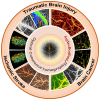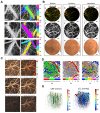Optical coherence tomography (OCT) and OCT angiography: Technological development and applications in brain science
- PMID: 39744229
- PMCID: PMC11667229
- DOI: 10.7150/thno.97192
Optical coherence tomography (OCT) and OCT angiography: Technological development and applications in brain science
Abstract
Brain diseases are a leading cause of disability and death worldwide. Early detection can lead to earlier intervention and better outcomes for patients. In recent years, optical coherence tomography (OCT) and OCT angiography (OCTA) imaging have been widely used in stroke, traumatic brain injury (TBI), and brain cancer due to their advantages of in vivo, unlabeled, and high-resolution 3D microvessel imaging at the capillary resolution level. This review summarizes recent advances and challenges in living brain imaging using OCT/OCTA, including technique modality, types of diseases, and theoretical approach. Although there may still be many limitations, with the development of lasers and the advances in artificial intelligence are expected to enable accurate detection of deep cerebral hemodynamics and guide intraoperative tumor resection in vivo in the future.
Keywords: brain cancer; ischemic stroke; optical coherence tomography; traumatic brain injury.
© The author(s).
Conflict of interest statement
Competing Interests: The authors have declared that no competing interest exists.
Figures









Similar articles
-
Optical Coherence Tomography Angiography.2024 Oct 6. In: StatPearls [Internet]. Treasure Island (FL): StatPearls Publishing; 2025 Jan–. 2024 Oct 6. In: StatPearls [Internet]. Treasure Island (FL): StatPearls Publishing; 2025 Jan–. PMID: 33085382 Free Books & Documents.
-
Retinal applications of swept source optical coherence tomography (OCT) and optical coherence tomography angiography (OCTA).Prog Retin Eye Res. 2021 Sep;84:100951. doi: 10.1016/j.preteyeres.2021.100951. Epub 2021 Jan 28. Prog Retin Eye Res. 2021. PMID: 33516833 Review.
-
Microscope-integrated optical coherence tomography for in vivo human brain tumor detection with artificial intelligence.J Neurosurg. 2024 May 3;141(5):1343-1351. doi: 10.3171/2024.1.JNS231511. Print 2024 Nov 1. J Neurosurg. 2024. PMID: 38701517
-
Optical coherence tomography angiography: A comprehensive review of current methods and clinical applications.Prog Retin Eye Res. 2017 Sep;60:66-100. doi: 10.1016/j.preteyeres.2017.07.002. Epub 2017 Jul 29. Prog Retin Eye Res. 2017. PMID: 28760677 Free PMC article. Review.
-
Quantitative hemodynamic analysis of cerebral blood flow and neurovascular coupling using optical coherence tomography angiography.J Cereb Blood Flow Metab. 2019 Oct;39(10):1983-1994. doi: 10.1177/0271678X18773432. Epub 2018 May 14. J Cereb Blood Flow Metab. 2019. PMID: 29757059 Free PMC article.
Cited by
-
Hallmarks of Brain Plasticity.Biomedicines. 2025 Feb 13;13(2):460. doi: 10.3390/biomedicines13020460. Biomedicines. 2025. PMID: 40002873 Free PMC article. Review.
References
-
- Zwanenburg JJ, Hendrikse J, Takahara T, Visser F, Luijten PR. MR angiography of the cerebral perforating arteries with magnetization prepared anatomical reference at 7 T: comparison with time-of-flight. J Magn Reson Imaging. 2008;28(6):1519–1526. - PubMed
-
- Villablanca JP, Nael K, Habibi R, Nael A, Laub G, Finn JP. 3 T contrast-enhanced magnetic resonance angiography for evaluation of the intracranial arteries: comparison with time-of-flight magnetic resonance angiography and multislice computed tomography angiography. Invest Radiol. 2006;41(11):799–805. - PubMed
-
- Hori M, Shiraga N, Watanabe Y, Aoki S, Isono S, Yui M. et al. Time-resolved three-dimensional magnetic resonance digital subtraction angiography without contrast material in the brain: Initial investigation. J Magn Reson Imaging. 2009;30(1):214–218. - PubMed
-
- de Havenon A, Mossa-Basha M, Shah L, Kim SE, Park M, Parker D. et al. High-resolution vessel wall MRI for the evaluation of intracranial atherosclerotic disease. Neuroradiology. 2017;59(12):1193–1202. - PubMed
Publication types
MeSH terms
LinkOut - more resources
Full Text Sources

